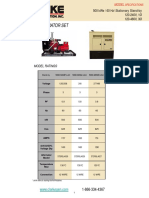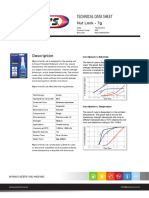Irc 117 2015 FWD RIGID
Irc 117 2015 FWD RIGID
Uploaded by
Suyog GoreCopyright:
Available Formats
Irc 117 2015 FWD RIGID
Irc 117 2015 FWD RIGID
Uploaded by
Suyog GoreOriginal Title
Copyright
Available Formats
Share this document
Did you find this document useful?
Is this content inappropriate?
Copyright:
Available Formats
Irc 117 2015 FWD RIGID
Irc 117 2015 FWD RIGID
Uploaded by
Suyog GoreCopyright:
Available Formats
Sr.
Remark No. Details - IRC 117 2015
within 5 years of construction, the pavement thicknesses is enough to prevent flexural cracking (stresses due to heavy axle loads + temperature gradients)
major cause of damage to a concrete pavement is due to the permanent deformation caused to granular layers and the subgrade due to the heavy vehicles
operating on highways
Evaluation - location of voids below the pavement + Conditions of dowel bars and tie bars + shoulder joints
FWD used for estimating the strength of the pavement concrete + modulus of the subgrade reaction
Find - The deflection data can be used to detect voids at transverse joints, longitudinal joints, interiors, corners
IRC:58-2011 Evaluation - pavement capacity to withstand future traffic loading i.e. balance life of the pavement, determined using cumulative fatigue damage principle
Structural Evaluation - load transfer at transverse and longitudinal joints
Rehabilitation Method
Appendix 1 cement grouting
IRC:SP:83-
2008 retrofitting of dowel bars/tie bars - Special Technique for Rehabilitation of Rigid Pavement
3. CONSTRUCTION HISTORY
i) Month and the year of construction
ii) Traffic considered in pavement design
iii) Thickness and strength of pavement concrete
iv) Thickness and strength of dry lean concrete subbase
v) CBR of subgrade
vi) Modulus of subgrade reaction considered in design
vii) Temperature differential of pavement concrete
IRC:58-2011 4. TRAFFIC
4.1 Axle Load Survey - conducted for 48 hours bothin day as well as in night hours, covering a minimum sample size of 10 percent in both directions
4.2 Axle Load Spectrum
5. FWD
The target peak load in the range of 40 kN to 60 kN or higher may be applied on concrete pavements to get a reasonable deflection of the order of 0.15 mm
since pavements of major highways in India consisting of 150 mm DLC and 300 mm PQC are very stiff and a higher load may be required to get a deflection of
about 0.15 mm.
IRC:115-2014 Calibration
6. PAVEMENT EVALUATION PROCESS
Appendix 2 Pavement Condition Survey
GPR may be used to determine the thickness of pavements in a short time and to locate approximately the areas where voids may have formed below the
pavement slab which can be confirmed by FWD deflection tests at a later stage.
FWD deflection data may be collected at interiors, corners, transverse joints and longitudinal joints in the outer lane at intervals of 500 m.
Heavy loads travel mostly in outer lanes and very often greater distresses also are found in the outer lanes.
If there are distresses in the inner lanes also, FWD test should be done in those lanes also.
two way two lane roads - both lanes have to be tested for corner, edge, interior, transverse and longitudinal joint loading
Spacing for tests can be lower depending upon the condition of pavements
Temperature
interior - temperature gradient is zero or negative when top surface is cooler than the bottom and the central portion of the pavement slab is in full contact
with the foundation.
These factors should be considered while carrying out the test.
day time - the surface is hotter than the bottom and the slab will curl up forming a convex surface with raised central region - The test in the raised part will
show high deflection. The edges will be resting on the foundation
Night Time - edges will get raised and test at the edge will give large deflections
Two lane roads without concrete shoulder - test should be carried out at the corner, interior and edge positions
When there are no dowel bars, tests at the transverse joints should be carried out in the morning hours to determine the load transfer due to aggregate
interlock when the joint opening will be higher because of contraction of slabs at lower temperatures.
6.2 Surface Temperature Measurement
The FWD can automatically measure and record the pavement surface temperature to the FWD file (infrared thermometer)
If the FWD is not equipped with an Infrared thermometer, then the FWD operator can use a hand held thermometer and record the temperature to a file.
FWD operator can suspend testing if the pavement becomes too hot (>40°C)
6.3 Evaluation of Subgrade Modulus, Elastic Modulus of Concrete and Strength of Pavement Concrete
Radius of relative stiffness (/) (extent to which object resist deformation)
Elastic Modulus (MPa) of concrete
IRC:58-2011 6.4 Fatigue Behaviour of Cement Concrete
7. CAUSES OF EARLY CRACKING OF CONCRETE PAVEMENTS
8. DETECTION OF VOIDS UNDERNEATH THE RIGID PAVEMENT
plot graph of central deflection vs distance
FWD Tests should be done during the period when the pavements are not in curled conditions
Compare tests done on a pavement slab over a void and a slab without any void at different load levels such as 40 kN, 50 kN, 60 kN and 70 kN or 80 kN
Appendix 4 9. EVALUATION OF LOAD TRANSFER EFFICIENCY OF JOINTS
LTE = 100 (D2/D1)
D1 is the deflection on the loaded side of the slab
D2 is the deflection on the unloaded side of the slab
For a new pavement, the joint efficiency is nearly 100 percent
10. FREQUENCY OF TEST - repeated between three and five years
You might also like
- Engine Mechanical TextbookDocument69 pagesEngine Mechanical TextbookTrương Ngọc ThắngNo ratings yet
- Ministrycirculars PDFDocument80 pagesMinistrycirculars PDFnaba1577100% (1)
- VDF CalculationDocument4 pagesVDF CalculationswarupmandalNo ratings yet
- Calibration Survey of Bump Integrator-MERLIN 2015 Non BUBDocument8 pagesCalibration Survey of Bump Integrator-MERLIN 2015 Non BUBMohan Mylarappa100% (1)
- GEOTRAN FWD AnalysisDocument19 pagesGEOTRAN FWD Analysisdigvijay singhNo ratings yet
- Railway Blanketing MaterialsDocument25 pagesRailway Blanketing MaterialsAnonymous FDEDRZXc0% (1)
- Test of Sand QualityDocument4 pagesTest of Sand QualityJamaludin100% (1)
- A Critical Review of Bituminous Paving Mixes Used in IndiaDocument20 pagesA Critical Review of Bituminous Paving Mixes Used in IndiaHimagiriNo ratings yet
- Indian HighwaysDocument95 pagesIndian HighwaysTLOFFICE PATNANo ratings yet
- BBD Report For NH-17 For Package-2Document9 pagesBBD Report For NH-17 For Package-2Ashok Kumar RajanavarNo ratings yet
- Quality Control Requirements For Using Crumb Rubber Modified Bitumen (CRMB) in Bituminous Mixtures PDFDocument6 pagesQuality Control Requirements For Using Crumb Rubber Modified Bitumen (CRMB) in Bituminous Mixtures PDFAkhilesh DwivediNo ratings yet
- INTERVIEWDocument5 pagesINTERVIEWMRITYUNJAY PANDEYNo ratings yet
- All Pavement MethologiesDocument17 pagesAll Pavement MethologiesCharismatic Srini VasanNo ratings yet
- Filter Media Page 1dimapurDocument10 pagesFilter Media Page 1dimapurAkash SarkarNo ratings yet
- Analysis of Flexible Pavements Using IIT Pave: Harish G RDocument4 pagesAnalysis of Flexible Pavements Using IIT Pave: Harish G RAyush KumarNo ratings yet
- IS 2720 Part 16 Lab CBRDocument17 pagesIS 2720 Part 16 Lab CBRchandra chanduNo ratings yet
- 09 - VV - Pavement Design IRC37-2018 - 29jan2020 - Admin KHRI PDFDocument24 pages09 - VV - Pavement Design IRC37-2018 - 29jan2020 - Admin KHRI PDFAmit Rajendra Phadatare100% (1)
- Letter To Highway Colleagues in India On Use of "Third Class" Bitumen Emulsion For Prime CoatDocument4 pagesLetter To Highway Colleagues in India On Use of "Third Class" Bitumen Emulsion For Prime CoatProf. Prithvi Singh Kandhal100% (1)
- Sec 400 (Most Version)Document37 pagesSec 400 (Most Version)abhijit_xpNo ratings yet
- Mix Design 2021Document137 pagesMix Design 2021Akh RhiNo ratings yet
- CTB Irc 37 2018Document14 pagesCTB Irc 37 2018Navarun VashisthNo ratings yet
- MoRTH Research Scheme R-81) PDFDocument182 pagesMoRTH Research Scheme R-81) PDFSunil BoseNo ratings yet
- Design of Overlay Flexible PavementDocument17 pagesDesign of Overlay Flexible PavementJoseph MathewNo ratings yet
- Final BC Grade 2 With VG 40 Honeywell Titan Polymer 56 HMP 1 Lime and 0.8 PolymerDocument15 pagesFinal BC Grade 2 With VG 40 Honeywell Titan Polymer 56 HMP 1 Lime and 0.8 PolymerSunil BoseNo ratings yet
- Falling Weight Deflectometer Test (FWD)Document20 pagesFalling Weight Deflectometer Test (FWD)ARTI PALEKAR100% (1)
- PDF Astm d4402 DDDocument3 pagesPDF Astm d4402 DDKAKA MADAFAKANo ratings yet
- Irc 117 2015Document22 pagesIrc 117 2015Komalesh CNo ratings yet
- Indian Standard: Methods of Test For Aggregates For ConcreteDocument18 pagesIndian Standard: Methods of Test For Aggregates For Concretes_prasy6540No ratings yet
- Subgrade Rutting AnalysisDocument2 pagesSubgrade Rutting Analysissuparna ghosh100% (1)
- Flexible Design - Geo Synthetic LCR MethodDocument14 pagesFlexible Design - Geo Synthetic LCR Methodarti100% (1)
- EB236Document26 pagesEB236mehrdad_so1981No ratings yet
- IRC - 67 - 2022 - Traffic SignDocument49 pagesIRC - 67 - 2022 - Traffic SignNATWAR PRAJAPATINo ratings yet
- Irc 063-1976Document9 pagesIrc 063-1976kruttika_apNo ratings yet
- Effect of Temperature On The RuttingDocument8 pagesEffect of Temperature On The RuttingPiyush SharmaNo ratings yet
- MBIU Report Gorakhpur BypassDocument167 pagesMBIU Report Gorakhpur BypassRaghav SharmaNo ratings yet
- Proposed Revisions To MORTH Specifications For Roads (Fifth Edition Dated 2013) by Prof. KandhalDocument14 pagesProposed Revisions To MORTH Specifications For Roads (Fifth Edition Dated 2013) by Prof. KandhalProf. Prithvi Singh KandhalNo ratings yet
- Pavement Design Report-R1Document38 pagesPavement Design Report-R1Harshit MoreNo ratings yet
- Irc 67 2022Document194 pagesIrc 67 2022RAGHAV SHARMANo ratings yet
- IRC 37 MORT&H - Standing Commitee Introduction of NEW TECHNOLOGY or ALTERNATE DES PDFDocument15 pagesIRC 37 MORT&H - Standing Commitee Introduction of NEW TECHNOLOGY or ALTERNATE DES PDFkhushwant Singh RaoNo ratings yet
- Analysis of Road Condition Using NSV VehicleDocument18 pagesAnalysis of Road Condition Using NSV VehiclePulakunta Achyuth ReddyNo ratings yet
- Test of Seal CoatDocument2 pagesTest of Seal CoatKUNAL PAULNo ratings yet
- Is 7317 (2020)Document16 pagesIs 7317 (2020)Kapil Jung ShahiNo ratings yet
- Ultratech PPC 53 Grade CementDocument1 pageUltratech PPC 53 Grade CementGovind SharmaNo ratings yet
- Thesis of USAGE OF GEOGRIDS IN FLEXIBLE PAVEMENT DESIGNDocument55 pagesThesis of USAGE OF GEOGRIDS IN FLEXIBLE PAVEMENT DESIGNAnonymous CQ4rbzLVE100% (1)
- Irc Gov in SP 100 2014 PDFDocument100 pagesIrc Gov in SP 100 2014 PDFGaneshkumar PandiyanNo ratings yet
- Layers of Flexible PavementDocument52 pagesLayers of Flexible Pavementsavan chavanNo ratings yet
- Is 1195-1978 Specification For Bitumen Mastic For FlooringDocument20 pagesIs 1195-1978 Specification For Bitumen Mastic For FlooringVijayakrishna Singamsetti100% (1)
- A Report On: Sub-Soil Investigation For The Proposed Construction of Minor Bridge Over Chora Nala at Ch. KM 4.000Document30 pagesA Report On: Sub-Soil Investigation For The Proposed Construction of Minor Bridge Over Chora Nala at Ch. KM 4.000Manvendra NigamNo ratings yet
- Contractor: G R Infraprojects Ltd. Coating and Stripping of Bitumen Aggregate MixturesDocument1 pageContractor: G R Infraprojects Ltd. Coating and Stripping of Bitumen Aggregate MixturesjitendraNo ratings yet
- Irc 115 2014 FWDDocument44 pagesIrc 115 2014 FWDp09tp451No ratings yet
- Research Lab. Punjab, PWD.B&R Br. Patiala - Name of Road: - IGC BATHINDADocument4 pagesResearch Lab. Punjab, PWD.B&R Br. Patiala - Name of Road: - IGC BATHINDAAyush GoyalNo ratings yet
- Irc Gov in 119 2015 PDFDocument37 pagesIrc Gov in 119 2015 PDFआशीष खोखर100% (1)
- Revision of IRC 82 (H-6) - CompressedDocument6 pagesRevision of IRC 82 (H-6) - CompressedGobinder Singh Virdee100% (1)
- Irc 16 2008Document20 pagesIrc 16 2008Lokesh100% (1)
- Soil Survey and Subgrade EvaluationDocument7 pagesSoil Survey and Subgrade EvaluationMiriam AmohNo ratings yet
- Pavement Evaluation and Rehabilitation Asst-OneDocument6 pagesPavement Evaluation and Rehabilitation Asst-Onesifan MirkenaNo ratings yet
- Structural Condition Evaluation of Flexible PavementsDocument17 pagesStructural Condition Evaluation of Flexible PavementsbilzinetNo ratings yet
- Unit 2.1Document40 pagesUnit 2.1naren0143No ratings yet
- On FALLING WEIGHT DEFLECTOMETERDocument30 pagesOn FALLING WEIGHT DEFLECTOMETERParvez100% (1)
- Comparative Study and Analysis of The Lateral and Vertical Loads of Pile FoundationDocument5 pagesComparative Study and Analysis of The Lateral and Vertical Loads of Pile FoundationRahul KolateNo ratings yet
- Why Soil Conditions Are Important To Solar DesignsDocument4 pagesWhy Soil Conditions Are Important To Solar DesignsNITIN MISHRANo ratings yet
- PCI CalculationDocument23 pagesPCI CalculationSuyog GoreNo ratings yet
- Irc 115 2014 FWD FLEXIBLEDocument4 pagesIrc 115 2014 FWD FLEXIBLESuyog GoreNo ratings yet
- Irc 67-2012 (Road Signages)Document11 pagesIrc 67-2012 (Road Signages)Suyog GoreNo ratings yet
- TOR TOT Preparation of Detailed Project Report On Physical Condition of The National Highways StretchesDocument6 pagesTOR TOT Preparation of Detailed Project Report On Physical Condition of The National Highways StretchesSuyog GoreNo ratings yet
- Four Laning Irc SP 84 2019Document3 pagesFour Laning Irc SP 84 2019Suyog Gore100% (2)
- Expressways Irc SP 99 2013Document4 pagesExpressways Irc SP 99 2013Suyog GoreNo ratings yet
- Six Laning Irc SP 87 2013Document3 pagesSix Laning Irc SP 87 2013Suyog GoreNo ratings yet
- Four Laning Irc SP 84 2019Document3 pagesFour Laning Irc SP 84 2019Suyog Gore100% (2)
- Consumer Behaviour and Utility AnalysisDocument4 pagesConsumer Behaviour and Utility AnalysismadhavNo ratings yet
- Finite Element AnalysisDocument2 pagesFinite Element Analysismythilispd_355305156No ratings yet
- Homology Modelling and AutodockDocument25 pagesHomology Modelling and AutodockGsbsggsbsjysbsnshsbNo ratings yet
- 2023 DSE M2 Suggested Solutions by JackyDocument20 pages2023 DSE M2 Suggested Solutions by JackyChristine TangNo ratings yet
- (Ebooks PDF) Download Artificial Intelligence in Manufacturing Research 1st Edition J. Paulo Davim Full ChaptersDocument84 pages(Ebooks PDF) Download Artificial Intelligence in Manufacturing Research 1st Edition J. Paulo Davim Full Chaptersmilakoffon100% (3)
- Dynamic Mechanical Properties of Photo Resist Thin Films: Mechanical Science and TechnologyDocument6 pagesDynamic Mechanical Properties of Photo Resist Thin Films: Mechanical Science and TechnologyAnand NagarajanNo ratings yet
- Computer PYQs For All Competitive Examination by Charles SirDocument791 pagesComputer PYQs For All Competitive Examination by Charles SirBingo Tedhe MedheNo ratings yet
- OMG Ergos3 8-10 TA3 Forklift BrochureDocument4 pagesOMG Ergos3 8-10 TA3 Forklift BrochureАндрей ГоряковNo ratings yet
- Timetable MTE23-24Document6 pagesTimetable MTE23-24Shantul KhandelwalNo ratings yet
- Piano-Chords-Major-Minor Letters PDFDocument1 pagePiano-Chords-Major-Minor Letters PDFbertlaxinaNo ratings yet
- Triforma Configuartion VariablesDocument17 pagesTriforma Configuartion VariablesPoppy LooksNo ratings yet
- FiinalDocument43 pagesFiinalAli NiazNo ratings yet
- Clarion Rh9448raDocument20 pagesClarion Rh9448raAndre VPNo ratings yet
- The ARC ProcessorDocument10 pagesThe ARC ProcessorDaniel LoveraNo ratings yet
- IC-306 Controller Leaflet Final PDFDocument4 pagesIC-306 Controller Leaflet Final PDFLaDuplicadoraCentroCopiadoNo ratings yet
- Wipro Coding SolutionsDocument24 pagesWipro Coding Solutionssai ChaitanyaNo ratings yet
- Care-Sheet For Your Messor Barbarus Colony (4 Pages Long)Document5 pagesCare-Sheet For Your Messor Barbarus Colony (4 Pages Long)Jayne wojtasikNo ratings yet
- ANOVA, Correlation and Regression: Dr. Faris Al Lami MB, CHB PHD FFPHDocument40 pagesANOVA, Correlation and Regression: Dr. Faris Al Lami MB, CHB PHD FFPHمحمود محمدNo ratings yet
- Merak Petroleum Economics Fundamentals 4 1 .X 95Document88 pagesMerak Petroleum Economics Fundamentals 4 1 .X 95Dulce Castro HernandezNo ratings yet
- Unit 1 - CA209 ZohaibDocument24 pagesUnit 1 - CA209 ZohaibZohaib Hasan KhanNo ratings yet
- Geography: B.A./B.Sc.: Elective and OptionalDocument4 pagesGeography: B.A./B.Sc.: Elective and OptionalMian Hidayat ShahNo ratings yet
- Causes of Over-VoltagesDocument19 pagesCauses of Over-VoltagesAbdurrahman shuaib100% (2)
- Symbol Scanner DS4308 ManulDocument520 pagesSymbol Scanner DS4308 Manulsathish77sNo ratings yet
- Diesel Engine Generator Set Diesel Engine-Generator Set: Model RatingsDocument4 pagesDiesel Engine Generator Set Diesel Engine-Generator Set: Model RatingsMalith MadushanNo ratings yet
- Drop BoxDocument20 pagesDrop BoxJhosep MesiasNo ratings yet
- Ic 695 Cpu 315Document14 pagesIc 695 Cpu 315Dilyalew DebreworkNo ratings yet
- Free Online Metronome - Real Metronome 4Document2 pagesFree Online Metronome - Real Metronome 4polNo ratings yet
- Nut Lock - 7g: Technical Data SheetDocument3 pagesNut Lock - 7g: Technical Data SheetAcarya DasNo ratings yet
- Standards Approvals & Certificates: Rutil-Bazik Örtülü Elektrod - Non Alloyed SteelsDocument1 pageStandards Approvals & Certificates: Rutil-Bazik Örtülü Elektrod - Non Alloyed SteelsBeshoy RedaNo ratings yet
































































































